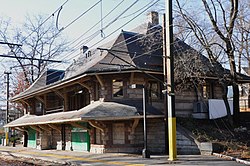Newton Railroad Stations Historic District
|
Woodland, Newton Highlands, and Newton Centre Railroad Stations, and Baggage and Express Building
|
|

Newton Highlands station in 2011
|
|
| Location | Newton, Massachusetts |
|---|---|
| Built | 1886-1891 |
| Architect | Henry Hobson Richardson; Shepley, Rutan & Coolidge |
| Architectural style | Richardsonian Romanesque |
| NRHP Reference # | 76002137 |
| Added to NRHP | March 25, 1976 |
The Newton Railroad Stations Historic District in Newton, Massachusetts is composed of three geographically separate historic railroad stations and one baggage/express building on the former Boston and Albany Railroad Highland Branch, which was converted to MBTA Green Line "D" Branch in 1959.
The four buildings in Newton plus Allston are the only extant stations of thirteen designed by H.H. Richardson and his successors Shepley, Rutan, and Coolidge in Allston/Brighton, Newton, and Brookline for the B&A's Newton Circuit between 1881 and 1894. Most originally had their grounds designed by landscape architect Frederick Law Olmsted, but none of the landscaping has survived.
On March 25, 1976, the district was added to the National Register of Historic Places as the Woodland, Newton Highlands, and Newton Centre Railroad Stations, and Baggage and Express Building.
The component buildings in the district are:
The B&A commissioned buildings from H.H. Richardson for three new stops at Boylston Street, Beacon Street, and Washington Street (later called 'Woodland) in October 1884. The three stations were built in largely unoccupied areas of Newton, and the attractive architecture was intended to bring in new residents who would become paying customers of the railroad. By this time, Richardson was in failing health; his successors Shepley, Rutan and Coolidge may have done most of the design work. Construction by the Norcross Brothers firm began in June 1886 - two months after Richardson's death - and finished that September. Similar to the other stations on the line, it was built in the heavy stone Richardsonian Romanesque style with a dominant roofline. The corners facing the tracks were cut back to serve as porches.
...
Wikipedia
